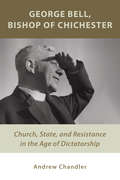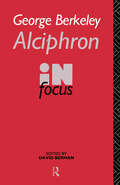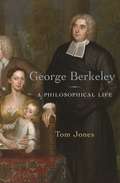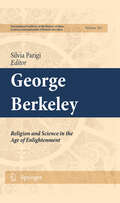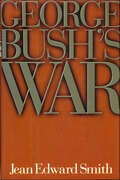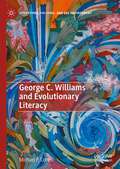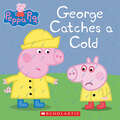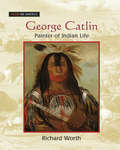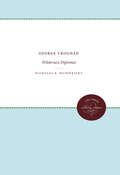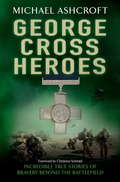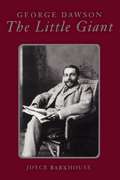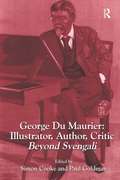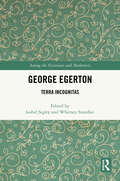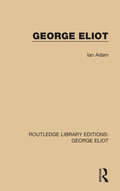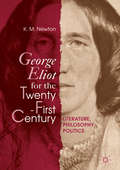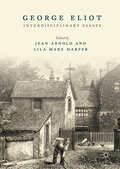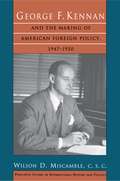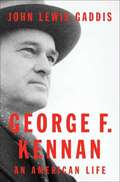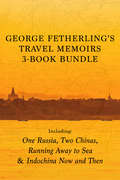- Table View
- List View
George Bell, Bishop of Chichester: Church, State, and Resistance in the Age of Dictatorship (The\selected Letters And Papers Of George Bell, Bishop Of Chichester Ser.)
by Andrew ChandlerThe story of a significant British church leader who fought for justice and freedom during World War IIIt was to George Bell, an English bishop, that Dietrich Bonhoeffer sent his last words before he was executed at the Flossenbürg concentration camp in April 1945. Why he did so becomes clear from Andrew Chandler's new biography of George Kennedy Allen Bell (1883–1958).As he traces the arc of Bell's life, Chandler reshapes our perspective on Bonhoeffer's life and times. In addition to serving as bishop of Chichester, Bell was an internationalist and ecumenical leader, one of the great Christian humanists of the twentieth century, a tenacious critic of the obliteration bombing of enemy cities during World War II, and a key ally of those who struggled for years to resist Hitler in Germany itself.This inspiring biography raises important questions that still haunt the moral imagination today: When should the word of protest be spoken? When should nations go to war, and how should they fight? What are our obligations to the victims of dictators and international conflict?
George Bell, Bishop of Chichester: Church, State, and Resistance in the Age of Dictatorship (The\selected Letters And Papers Of George Bell, Bishop Of Chichester Ser.)
by Andrew ChandlerThe story of a significant British church leader who fought for justice and freedom during World War IIIt was to George Bell, an English bishop, that Dietrich Bonhoeffer sent his last words before he was executed at the Flossenbürg concentration camp in April 1945. Why he did so becomes clear from Andrew Chandler's new biography of George Kennedy Allen Bell (1883–1958).As he traces the arc of Bell's life, Chandler reshapes our perspective on Bonhoeffer's life and times. In addition to serving as bishop of Chichester, Bell was an internationalist and ecumenical leader, one of the great Christian humanists of the twentieth century, a tenacious critic of the obliteration bombing of enemy cities during World War II, and a key ally of those who struggled for years to resist Hitler in Germany itself.This inspiring biography raises important questions that still haunt the moral imagination today: When should the word of protest be spoken? When should nations go to war, and how should they fight? What are our obligations to the victims of dictators and international conflict?
George Berkeley Alciphron in Focus (Philosophers in Focus)
by David BermanAlciphron, or the Minute Philosopher (1732) is Berkeley's main work of philosophical theology and a crucial source of his views on meaning and language. This edition contains the four most important dialogues and a selection of critical essays and commentaries reflecting the response of such writers as Hutcheson, Mill and Antony Flew. The only single edition currently in print, it argues that Alciphron has a more important place both in the Berkeley canon and in early modern philosophy than is generally thought.
George Berkeley: A Philosophical Life
by Tom JonesA comprehensive intellectual biography of the Enlightenment philosopherIn George Berkeley: A Philosophical Life, Tom Jones provides a comprehensive account of the life and work of the preeminent Irish philosopher of the Enlightenment. From his early brilliance as a student and fellow at Trinity College Dublin to his later years as Bishop of Cloyne, Berkeley brought his searching and powerful intellect to bear on the full range of eighteenth-century thought and experience.Jones brings vividly to life the complexities and contradictions of Berkeley’s life and ideas. He advanced a radical immaterialism, holding that the only reality was minds, their thoughts, and their perceptions, without any physical substance underlying them. But he put forward this counterintuitive philosophy in support of the existence and ultimate sovereignty of God. Berkeley was an energetic social reformer, deeply interested in educational and economic improvement, including for the indigenous peoples of North America, yet he believed strongly in obedience to hierarchy and defended slavery. And although he spent much of his life in Ireland, he followed his time at Trinity with years of travel that took him to London, Italy, and New England, where he spent two years trying to establish a university for Bermuda, before returning to Ireland to take up an Anglican bishopric in a predominantly Catholic country.Jones draws on the full range of Berkeley’s writings, from philosophical treatises to personal letters and journals, to probe the deep connections between his life and work. The result is a richly detailed and rounded portrait of a major Enlightenment thinker and the world in which he lived.
George Berkeley: Religion and Science in the Age of Enlightenment
by Silvia ParigiGeorge Berkeley was considered "the most engaging and useful man in Ireland in the eighteenth century". This hyperbolic statement refers both to Berkeley's life and thought; in fact, he always considered himself a pioneer called to think and do new things. He was an empiricist well versed in the sciences, an amateur of the mechanical arts, as well as a metaphysician; he was the author of many completely different discoveries, as well as a very active Christian, a zealous bishop and the apostle of the Bermuda project. The essays collected in this volume, written by some leading scholars, aim to reconstruct the complexity of Berkeley's figure, without selecting "major" works, nor searching for "coherence" at any cost. They will focus on different aspects of Berkeley's thought, showing their intersections; they will explore the important contributions he gave to various scientific disciplines, as well as to the eighteenth-century philosophical and theological debate. They will highlight the wide influence that his presently most neglected or puzzling books had at the time; they will refuse any anachronistical trial of Berkeley's thought, judged from a contemporary point of view.
George Bush's War
by Jean Edward SmithGeorge Bush's War by Jean Edward Smith chronicles the complete history of the 1991 Persian Gulf War. Smith takes the reader from the politics of Desert Shield to the military action of Desert Storm."Expressing constant misgivings about presidential warmaking, [Smith] provides a virtual day-by-day chronicle of the decisions of 1990 that led to war ... Highly recommended.” —Library Journal
George C. Marshall: Ordeal And Hope, 1939-1942
by Forrest PogueMarshall is seen here in all his public and private dealing with the other soldiers, statesmen, and politicians who shaped the course of the war.
George C. Williams and Evolutionary Literacy (Literatures, Cultures, and the Environment)
by Michael P. CohenIn this book, a case study of a humanistic reading of an essential evolutionary theorist, George C. Williams (May 12, 1926–September 8, 2010), the author contends that certain classic works of evolutionary theory and history are the most important nature writing of recent times. What it means to be scientifically literate—is essential for humanistic scholars, who must ground themselves with literary reading of scientific texts. As the most influential American evolutionary theorist of the second half of the twentieth century, Williams masters critique, frames questions about adaptation and natural selection, and answers in a plain, aphoristic writing style. Williams aims for parsimony—to “recognize adaptation at the level necessitated by the facts and no higher”—through a minimalist writing style. This voice articulates a powerful process that operates at very low levels by blind and selfish chance at the expense of its designed products, using purely trial and error.
George Catches a Cold (Geronimo Stilton Cavemice Ser.)
by ScholasticGeorge gets a visit from Dr. Brown Bear after he catches a cold in the rain. Based on the hit animated TV show as seen on Nick Jr.Peppa and George love to play outside in the rain, but George does not want to wear his rain hat. He has a great time jumping in muddy puddles with Peppa--but then he catches a cold! It's time for a visit from Dr. Brown Bear. How long will it take for George to feel better? Find out in this illustrated storybook based on the hit Nick Jr. animated TV show!
George Catlin: Painter of Indian Life
by Richard WorthFirst Published in 2009. Routledge is an imprint of Taylor & Francis, an informa company.
George Croghan: Wilderness Diplomat (Published by the Omohundro Institute of Early American History and Culture and the University of North Carolina Press)
by Nicholas B. WainwrightGeorge Croghan--land speculator, Indian trader, and prominent Indian agent--was a man of fascinating, if dubious, character whose career epitomized the history of the West before the Revolution. This study is based on Croghan's long-lost personal papers that were found by the author in an old Philadelphia attic.Originally published in 1959.A UNC Press Enduring Edition -- UNC Press Enduring Editions use the latest in digital technology to make available again books from our distinguished backlist that were previously out of print. These editions are published unaltered from the original, and are presented in affordable paperback formats, bringing readers both historical and cultural value.
George Cross Heroes
by Michael AshcroftThis ebook edition contains the full text version as per the book; but doesn't include original photographic and illustrated material. In a broadcast to the nation in September 1940 King George VI announced the institution of the George Cross - a civilian equivalent of the Victoria Cross awarded to recognize the many acts of supreme gallantry being performed outside of the battlefield. From Thomas Alderson, the first recipient of the medal, who heroically rescued several people from trapped houses during one terrible Blitz night, to Lance Corporal Matthew Croucher, who threw himself onto a live grenade in the Helmand province to save the lives of his comrades (and somehow survived), to Barbara Harrison, an air stewardess who died in 1968 after helping many passengers escape from an onboard fire, this book tells the amazing stories of everyone of the George Cross's 159 direct recipients. GEORGE CROSS HEROES pays tribute to the extraordinary courage displayed by so many of the commonwealth's men and women in so many incredible situations over the last 70 years.
George Cross Heroes
by Michael AshcroftThis ebook edition contains the full text version as per the book; but doesn't include original photographic and illustrated material. In a broadcast to the nation in September 1940 King George VI announced the institution of the George Cross - a civilian equivalent of the Victoria Cross awarded to recognize the many acts of supreme gallantry being performed outside of the battlefield. From Thomas Alderson, the first recipient of the medal, who heroically rescued several people from trapped houses during one terrible Blitz night, to Lance Corporal Matthew Croucher, who threw himself onto a live grenade in the Helmand province to save the lives of his comrades (and somehow survived), to Barbara Harrison, an air stewardess who died in 1968 after helping many passengers escape from an onboard fire, this book tells the amazing stories of everyone of the George Cross's 159 direct recipients. GEORGE CROSS HEROES pays tribute to the extraordinary courage displayed by so many of the commonwealth's men and women in so many incredible situations over the last 70 years.
George Cukor: A Double Life
by Patrick McGilliganOne of the highest-paid studio contract directors of his time, George Cukor was nominated five times for an Academy Award as Best Director. In publicity and mystique he was dubbed the &“women&’s director&” for guiding the most sensitive leading ladies to immortal performances, including Greta Garbo, Ingrid Bergman, Judy Garland, and—in ten films, among them The Philadelphia Story and Adam&’s Rib—his lifelong friend and collaborator Katharine Hepburn. But behind the &“women&’s director&” label lurked the open secret that set Cukor apart from a generally macho fraternity of directors: he was a homosexual, a rarity among the top echelon. Patrick McGilligan&’s biography reveals how Cukor persevered within a system fraught with bigotry while becoming one of Hollywood&’s consummate filmmakers.
George Dawson: The Little Giant
by Joyce BarkhouseAn exceptional man, George Mercer Dawson (1849-1901) a tiny hunchback, may have contributed more than any other person to early knowledge of the geology, biology and ethnology of Canada’s Northwest. Possessed of a brilliant mind, boundless enthusiasm, an insatiable thirst for knowledge, and a great love of the land, he made some of the most epic exploratory journeys in Canadian history. His maps and reports remain invaluable reference sources. Both Dawson City and Dawson Creek are named in his honour. This book tells the story of some of his life experiences and adventures.
George Du Maurier: Beyond Svengali
by Simon Cooke Paul GoldmanThough well-known as the author of Trilby and the creator of Svengali, the writer-artist George Du Maurier had many other accomplishments that are less familiar to modern audiences. This collection traces Du Maurier’s role as a participant in the wider cultural life of his time, restoring him to his proper status as a major Victorian figure. Divided into sections, the volume considers Du Maurier as an artist, illustrator and novelist who helped to form some of the key ideas of his time. The contributors place his life and work in the context of his treatment of Judaism and Jewishness; his fascination with urbanization, Victorian science, technology and clairvoyance; his friendships and influences; and his impact on notions of consumerism and taste. As an illustrator, Du Maurier collaborated with Thomas Hardy, Elizabeth Gaskell and sensational writers such as M. E. Braddon and the author of The Notting Hill Mystery. These partnerships, along with his reflections on the art of illustration, are considered in detail. Impossible to categorize, Du Maurier was an Anglo-Frenchman with cultural linkages in France, England, and America; a social commentator with an interest in The New Woman; a Punch humourist; and a friend of Henry James, with whom he shared a particular interest in the writing of domesticity and domestic settings. Closing with a consideration of Du Maurier’s after-life, notably the treatment of his work in film, this collection highlights his diverse achievements and makes a case for his enduring significance.
George Egerton: Terra Incognitas (Among the Victorians and Modernists)
by Whitney Standlee Isobel SigleyGeorge Egerton: Terra Incognitas is the first published work to focus solely on Egerton and her literary legacy. It covers the range and extent of Egerton's life and literary career from her emergence into the milieu of London publishing in 1893 to her dramatic works (both original and in translation) and their performance history into the 1920s. This work is an essential addition to ongoing recovery projects and is the first to focus on her 'lost' and unpublished works, mentorship of younger writers, her experiments with characterisations and themes, sociopolitical stances, innovations with form and content, and ultimately, her literary legacy. In doing so, George Egerton: Terra Incognitas reassesses Egerton's broader contribution to fin-de-siècle and early-twentieth-century literature and drama and repositions her as among the most important of the literary innovators of period, and a noteworthy precursor to later female literary modernisers, including Katherine Mansfield, Dorothy Richardson, Elizabeth Bowen and Virginia Woolf.
George Eliot (Routledge Library Editions: George Eliot #1)
by Ian AdamFirst published in 1969. George Eliot is a writer of ordinary human experience, whose work emphasizes commonplace characters and commonplace situations. Her mind, however, was far from ordinary. Professor Adam shows how wit, observation and sympathy, combined with a lucid and energetic intelligence, enabled her to invest the commonplace with complexity and importance. Extracts from George Eliot’s major novels illustrate her treatment of character, setting, dialogue and narrative, while the author’s commentary discusses the particulars of her artistic procedures and techniques. This title will be of interest to students of literature.
George Eliot and Schiller: Intertextuality and cross-cultural discourse (Routledge Library Editions: The Nineteenth-Century Novel #18)
by Deborah GuthThough Friedrich Schiller enjoyed prominent literary standing and great popularity in nineteenth century literary England, his influence has been largely neglected in recent scholarship on the period. First published in 2003, this book explores the substantial evidence of the importance of the playwright and philosopher’s thought to George Eliot’s novelistic art. It demonstrates the relationship between Schiller’s work and Eliot’s plotting of moral vision, the tensions in her work between realism and idealism, and her aesthetics. It also contends that the immense continental underpinnings of Eliot’s writing should lead us to resituate her beyond national boundaries, and view her as a major European, as well as English, writer. This book will be of interest to those studying 19th Century English and European literature.
George Eliot for the Twenty-First Century: Literature, Philosophy, Politics
by K. M. NewtonGeorge Eliot for the Twenty-First Century reexamines Eliot two hundred years after her birth and offers an innovative critical reading that seeks to change perceptions of Eliot. Tracing Eliot’s literary reception from the nineteenth century to the late twentieth and early twenty-first century, K. M. Newton frames Eliot as an unorthodox radical and considers the philosophical, ethical, political, and artistic subtleties permeating her writings. Drawing from close readings of her novels, essays, and letters, Newton offers a new critical perspective on George Eliot and reveals her enduring relevance in the twenty-first century.
George Eliot: Interdisciplinary Essays
by Jean Arnold Lila Marz HarperThis collection brings together new articles by leading scholars who reappraise George Eliot in her bicentenary year as an interdisciplinary thinker and writer for our times. Here, researchers, students, teachers and the general public gain access to new perspectives on Eliot’s vast interests and knowledge, informed by the nineteenth-century British culture in which she lived. Examining Eliot’s wide-ranging engagement with Victorian historical research, periodicals, poetry, mythology, natural history, realism, the body, gender relations, and animal studies, these essays construct an exciting new interdisciplinary agenda for future Eliot studies.
George F. Kennan
by John Lewis GaddisWinner of the Pulitzer Prize Winner of the National Book Critics Circle Award Selected by The New York Times Book Review as a Notable Book of the Year Drawing on extensive interviews with George Kennan and exclusive access to his archives, an eminent scholar of the Cold War delivers a revelatory biography of its troubled mastermind. In the late 1940s, George Kennan wrote two documents, the "Long Telegram" and the "X Article," which set forward the strategy of containment that would define U. S. policy toward the Soviet Union for the next four decades. This achievement alone would qualify him as the most influential American diplomat of the Cold War era. But he was also an architect of the Marshall Plan, a prizewinning historian, and would become one of the most outspoken critics of American diplomacy, politics, and culture during the last half of the twentieth century. Now the full scope of Kennan's long life and vast influence is revealed by one of today's most important Cold War scholars. Yale historian John Lewis Gaddis began this magisterial history almost thirty years ago, interviewing Kennan frequently and gaining complete access to his voluminous diaries and other personal papers. So frank and detailed were these materials that Kennan and Gaddis agreed that the book would not appear until after Kennan's death. It was well worth the wait: the journals give this book a breathtaking candor and intimacy that match its century-long sweep. We see Kennan's insecurity as a Midwesterner among elites at Princeton, his budding dissatisfaction with authority and the status quo, his struggles with depression, his gift for satire, and his sharp insights on the policies and people he encountered. Kennan turned these sharp analytical gifts upon himself, even to the point of regularly recording dreams. The result is a remarkably revealing view of how this greatest of Cold War strategists came to doubt his strategy and always doubted himself. This is a landmark work of history and biography that reveals the vast influence and rich inner landscape of a life that both mirrored and shaped the century it spanned.
George F. Kennan and the Making of American Foreign Policy, 1947-1950 (Princeton Studies in International History and Politics #38)
by Wilson D. Miscamble, C.S.C.When George C. Marshall became Secretary of State in January of 1947, he faced not only a staggering array of serious foreign policy questions but also a State Department rendered ineffective by neglect, maladministration, and low morale. Soon after his arrival Marshall asked George F. Kennan to head a new component in the department's structure--the Policy Planning Staff. Here Wilson Miscamble scrutinizes Kennan's subsequent influence over foreign policymaking during the crucial years from 1947 to 1950.
George F. Kennan: An American Life
by John Lewis GaddisSelected by The New York Times Book Review as a Notable Book of the Year. Drawing on extensive interviews with George Kennan and exclusive access to his archives, an eminent scholar of the Cold War delivers a revelatory biography of its troubled mastermind. In the late 1940s, George Kennan wrote two documents, the "Long Telegram" and the "X Article," which set forward the strategy of containment that would define U.S. policy toward the Soviet Union for the next four decades. This achievement alone would qualify him as the most influential American diplomat of the Cold War era. But he was also an architect of the Marshall Plan, a prizewinning historian, and would become one of the most outspoken critics of American diplomacy, politics, and culture during the last half of the twentieth century. Now the full scope of Kennan's long life and vast influence is revealed by one of today's most important Cold War scholars. Yale historian John Lewis Gaddis began this magisterial history almost thirty years ago, interviewing Kennan frequently and gaining complete access to his voluminous diaries and other personal papers. So frank and detailed were these materials that Kennan and Gaddis agreed that the book would not appear until after Kennan's death. It was well worth the wait: the journals give this book a breathtaking candor and intimacy that match its century-long sweep. We see Kennan's insecurity as a Midwesterner among elites at Princeton, his budding dissatisfaction with authority and the status quo, his struggles with depression, his gift for satire, and his sharp insights on the policies and people he encountered. Kennan turned these sharp analytical gifts upon himself, even to the point of regularly recording dreams. The result is a remarkably revealing view of how this greatest of Cold War strategists came to doubt his strategy and always doubted himself. This is a landmark work of history and biography that reveals the vast influence and rich inner landscape of a life that both mirrored and shaped the century it spanned.<P><P> Pulitzer Prize winner
George Fetherling's Travel Memoirs 3-Book Bundle: One Russia, Two Chinas / Running Away to Sea / Indochina Now and Then
by George FetherlingThe travel writing of celebrated writer George Fetherling is filled with vivid prose and bizarre characters. Includes: One Russia, Two Chinas A travel narrative written over the course of ten years, One Russia, Two Chinas is about change and resistance to change in the postmodern world. A valuable document that freezes some important world events for close inspection. Running Away to Sea: Round the World on a Tramp Freighter At a turning point in his life, George Fetherling embarked on an adventure to sail round the world on one of the last of the tramp freighters. The four-month voyage carried him 30,000 nautical miles from Europe via the Panama Canal to the South Pacific and back by way of Singapore, Indonesia, the Indian Ocean, and Suez. Written with dash, colour, and droll humour, Fetherling’s narrative is peopled by a rich cast of characters, from the Foreign Legionnaires of French Polynesia to the raskol gangs of Papua New Guinea. Indochina Now and Then George Fetherling recounts multiple journeys through Vietnam, Laos, and Cambodia, keeping an eye peeled and an ear cocked for whatever faint traces of French rule might remain. Indochina Now and Then is a travel narrative that leaves an indelible impression in the readers imagination.
